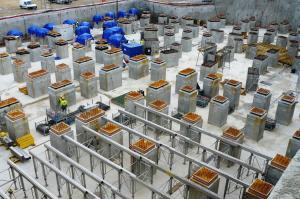The days the earth shook (lightly)
23 Jul 2010
In an interview with the local daily La Provence, Lina Rodriguez explained that the ITER Tokamak Complex will rest on about 600 seismic pads that will isolate it from ground motion in the case of an earthquake. © CEA - Le Sénéchal
A slight tremor was felt in Manosque on Thursday, 8 July, followed by another one last Wednesday—twenty days later. Could this be the sign of an impending earthquake? And if it is, what will be the consequences for the installations at CEA-Cadarache and ITER?
In the edition of the local daily newspaper La Provence of Friday 23 July, the best part of its front page and the totality of pages 2 and 3 were devoted to this subject. "Experts have no worry," read the large front page headline.
Michel Villeneuve, a specialist in geodynamics from the French National Scientific Research Center (CNRS), explained that "the more we'll have small earthquakes, the better." Tremors that reach a mere 2.3 to 3 on the Richter scale, he explained, enable the faults to dissipate their energy.
"I have no worry for Manosque," adds Villeneuve. Nor does the geophysicist worry for Cadarache "where the maximum risk is taken into consideration" in the design of the installations.
In another article, Lina Rodriguez, ITER head of the Safety Control Section, explained how the ITER Tokamak Complex will rest on about 600 seismic pads that will isolate it from ground motion in the case of an earthquake.
The article states in its conclusion that on the days Manosque felt the tremors, none of the 10,000 sensors installed on the Cadarache site registered the slightest movement.


